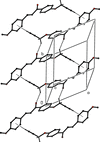issue contents
October 2021 issue

Cover illustration: Conformational flexibility within molecules of the serine protease inhibitor nafamostat influences its therapeutic characteristics. In the dimesylate salt of nafamostat, the divalent cation is twisted to give screw-like motifs, which pack via extensive hydrogen bonding into columnar structures. See: Fujii [Acta Cryst. (2021). E77, 999–1002].
Jerry P. Jasinski tribute
Download citation


Download citation


The reported molecule contains a number of unusual features, the most notable being a finite yet exceptionally long cyclic metal-azido chain. These rare features are the consequence of both sterically protecting Cp* ligands and highly bridging oxide and hydroxide ligands in the same system and illustrate the interesting new possibilities that can arise from combining organometallic and solvothermal f-block element chemistry.
CCDC reference: 2105511
Download citation


Download citation


(E)-1-(4-Methoxyphenyl)-3-[4-(prop-2-ynyloxy)phenyl]prop-2-en-1-one undergoes a cyclocondensation reaction with thiosemicarbazide to form the corresponding 4,5-dihydropyrazole-1-arbothioamide, which in turn undergoes further cycloaddition with phenacyl bromides to form 4,5-dihydro-1-(thiazol-2-yl)pyrazoles. The molecules adopt an overall T-shape structure. Different combinations of hydrogen bonds link the molecules into ribbons or sheets.
Download citation


Download citation


The crystal structures of two manganese(II) complexes have been determined. The manganese(II) centers of each structure are six-coordinate with a distorted octahedral geometry. Although the bis(quinolin-2-ylmethyl)ethanamine ligands differ only by a methyl group, the structure of one complex is dimeric with bridging acetate ligands and exhibits a trans coordination and coplanarity of the quinolyl moieties, while the second complex is monomeric with a cis coordination of the quinolyl groups.
research communications
Download citation


Download citation


6-Nitroquinazolin-4(3H)-one (C8H5N3O3), 6-aminoquinazolin-4(3H)-one (C8H7N3O) and 4-aminoquinazoline hemihydrochloride dihydrate (C16H19N6O2) were synthesized and their structures were determined by single-crystal X-ray analysis.
Download citation


Download citation


C—H⋯N interactions, C—Cl⋯π interactions, and π-π stacking interactions link molecules in the crystal, forming molecular layers approximately parallel to the (002) plane. The three-dimensional packing is strengthened by additional weak van der Waals interactions between the layers.
CCDC reference: 2107472
Download citation


Download citation


The crystal structure of nafamostat mesylate is reported, which is a serine protease inhibitor, and has been applied clinically as an anticoagulant and anti-inflammatory agent.
CCDC reference: 2107852
Download citation


Download citation


The title compounds Fe4(C7H4O3)O(C2H3O2)6(C5H5N)3X where X is either Cl or F were synthesized using a self-assembly reaction in methanol and pyridine with stoicometric addition of salicylhydroxamic acid (H3shi), acetic acid (HOAc), and the appropriate ferric halide salt. The compound is remeniscent of hydroximate binding in metallacrown structures.
Download citation


Download citation


In the racemic title compound, the [Co(en)3]3+ and [Na(H2O)6]+cations exist in distorted octahedral coordination environments and charge neutrality in the salt is furnished by Cl− anions. Structural cohesion is maintained by an array of C—H⋯O, N—H⋯Cl and O—H⋯Cl hydrogen bonds.
CCDC reference: 2042981
Download citation


Download citation


The investigation of the coordination chemistry of heterometallic transition-metal complexes of palladium (Pd) and rhenium (Re) led to the isolation and crystallographic characterization of tetrakis(1,3-dimethylimidazolium-2-ylidene)palladium(II) hexadecacarbonyltetrarhenium diethyl ether disolvate, [Pd(C5H8N2)4][Re4(CO)16]·2C4H10O or [Pd(IMe)4][Re4(CO)16]·2C4H10O, (1), and dicarbonylocta-μ-carbonyl-tetrakis(triphenylphosphane)palladiumdirhenium, [Pd4Re2(C18H15P)4(CO)10] or Pd4Re2(PPh3)4(μ-CO)8(CO)2, (2), from the reaction of Pd(PPh3)4 with 1,3-dimethylimidazolium-2-carboxylate and Re2(CO)10 in a toluene–acetonitrile mixture.
Download citation


Download citation


The polymer contains Li+ cations coordinated via oxygen to two cyanuranate anions and three water molecules in a trigonal–bipyramidal geometry and to three water molecules and an oxygen from the cyanuric anion in a tetrahedral geometry. A three-dimensional network of hydrogen bonds serves to hold the structure together.
CCDC reference: 1991191
Download citation


Download citation


A trisilver complex stabilized by two monoanionic bisphosphinimine ligands is reported. Noteworthy asymmetry at the cluster core is observed. This is the first example of a trisilver complex supported by monoanionic bisphosphinimine ligands.
CCDC reference: 2108219
Download citation


Download citation


The fluorene skeleton of the title molecule is nearly planar and the crystal structure is composed of molecular layers extending parallel to the 302 plane. A Hirshfeld surface analysis indicated that the most important contributions to the overall surface are from H⋯H, O⋯H and C⋯H interactions.
CCDC reference: 2109160
Download citation


Download citation


Octahedral [Fe(DMF)6]3+ and tetrahedral-based [Cd2Cl7]3− ions stack alternately along the c-axis direction in this rare example of a [Fe(DMF)6]3+-containing ionic salt.
CCDC reference: 2110079
Download citation


Download citation


The phenyl-quinoxaline moiety in the title compound is not planar. In the crystal, C—H⋯O hydrogen bonds between neighboring quinoxaline rings form chains along the a axis direction.
CCDC reference: 2110486
Download citation


Download citation


The title compound was obtained via a two-step synthesis (Dimroth reaction and amidation) for anticancer activity screening and was selected from a 1H-1,2,3-triazole-4-carboxamide library. The cyclopropyl ring is oriented almost perpendicular to the benzene ring [dihedral angle = 87.9 (1)°], while the dihedral angle between the mean plane of the cyclopropyl ring and that of the triazole ring is 55.6 (1)°. In the crystal, the molecules are linked by O—H⋯O and C—H⋯N interactions into infinite ribbons propagating in the [001] direction, which are interconnected by weak C—H⋯O interactions into layers.
CCDC reference: 736128
Download citation


Download citation


In the crystal, molecules are linked by C—H⋯O hydrogen bonds, forming layers parallel to the (001) plane. These layers of molecules are connected by C—H⋯π interactions along the c-axis direction. Interlayer van der Waals and interhalogen interactions stabilize the packing.
CCDC reference: 2095762
Download citation


Download citation


In this O-alkylated sulfonylpyrazolone, the sulfur atom lies 0.558 (1) Å out of the pyrazole ring plane. The NH2 group is involved in an intramolecular hydrogen bond to a sulfonyl oxygen atom and in a three-centre system with the two oxygen atoms of the side chain at C3, forming a ribbon structure.
CCDC reference: 2111897
Download citation


Download citation


A supramolecular two-dimensional polymer structure of caesium tetramethyldithioimidodiphosphinate is reported.
CCDC reference: 2110998


 journal menu
journal menu




































